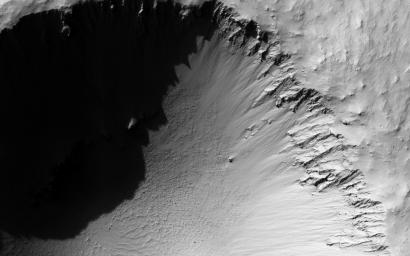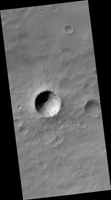
|
A Young, Fresh Crater in Hellespontus
- Click the image above for a larger view
- Full-Res JPEG (2880 x 1800) (525.0 kB)
- Full-Res TIFF (2880 x 1800) (4.7 MB)
Caption:

Map Projected Browse Image
Click on the image for larger version
This is a textbook example of a morphologically fresh and simple impact crater . At 1.3 kilometers in diameter, this unnamed crater is only slightly larger than Arizona's Barringer (aka Meteor) Crater, by about 200 meters. Note the simple bowl shape and the raised crater rim.
Rock and soil excavated out of the crater by the impacting meteor -- called ejecta -- forms the ejecta deposit. It is continuous for about one crater radius away from the rim and is likely composed of about 90 percent ejecta and 10 percent in-place material that was re-worked by both the impact and the subsequently sliding ejecta.
The discontinuous ejecta deposit extends from about one crater radius outward. Here, high velocity ejecta that was launched from close to the impact point -- and got the biggest kick -- flew a long way, landed, rolled, slid, and scoured the ground, forming long tendrils of ejecta and v-shaped ridges.
Background Info:
The University of Arizona, Tucson, operates HiRISE, which was built by Ball Aerospace & Technologies Corp., Boulder, Colo. NASA's Jet Propulsion Laboratory, a division of the California Institute of Technology in Pasadena, manages the Mars Reconnaissance Orbiter Project for NASA's Science Mission Directorate, Washington.
Cataloging Keywords:
| Name | Value | Additional Values |
|---|---|---|
| Target | Mars | |
| System | ||
| Target Type | Planet | |
| Mission | Mars Reconnaissance Orbiter (MRO) | |
| Instrument Host | Mars Reconnaissance Orbiter | |
| Host Type | Orbiter | |
| Instrument | High Resolution Imaging Science Experiment (HiRISE) | |
| Detector | ||
| Extra Keywords | Crater, Grayscale, Impact, Map | |
| Acquisition Date | ||
| Release Date | 2016-01-14 | |
| Date in Caption | ||
| Image Credit | NASA/JPL-Caltech/Univ. of Arizona | |
| Source | photojournal.jpl.nasa.gov/catalog/PIA20340 | |
| Identifier | PIA20340 | |
